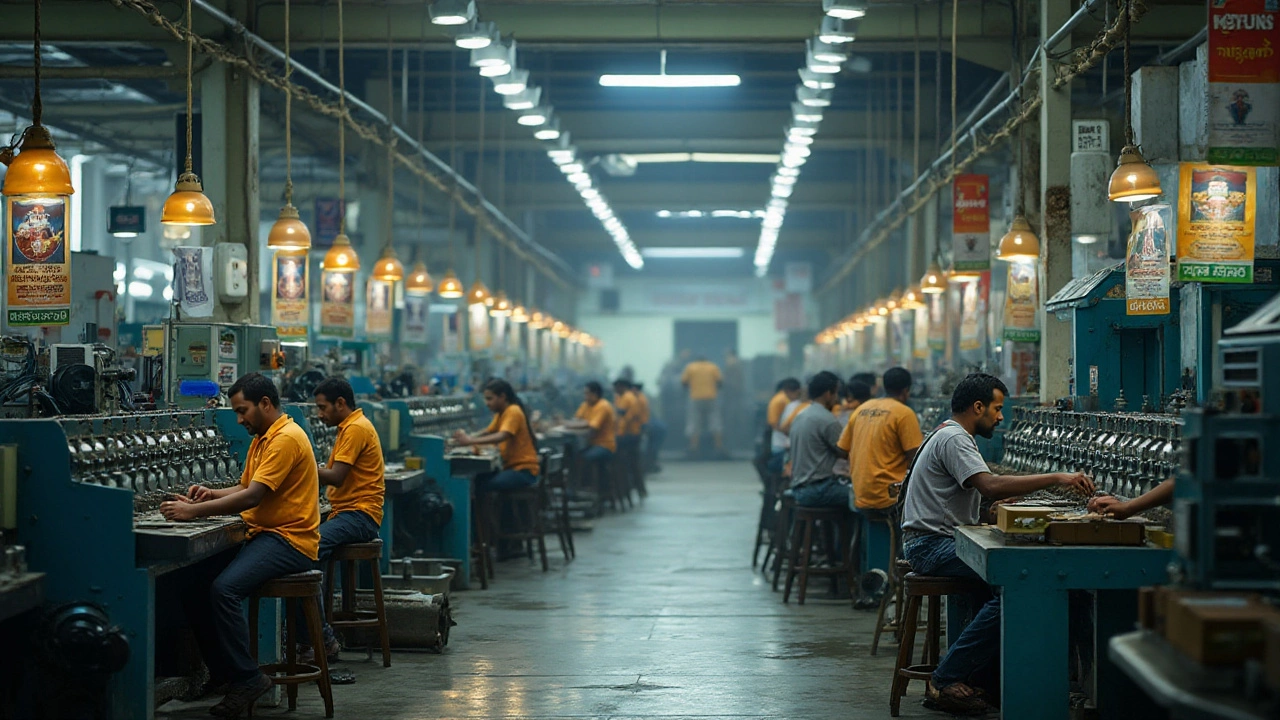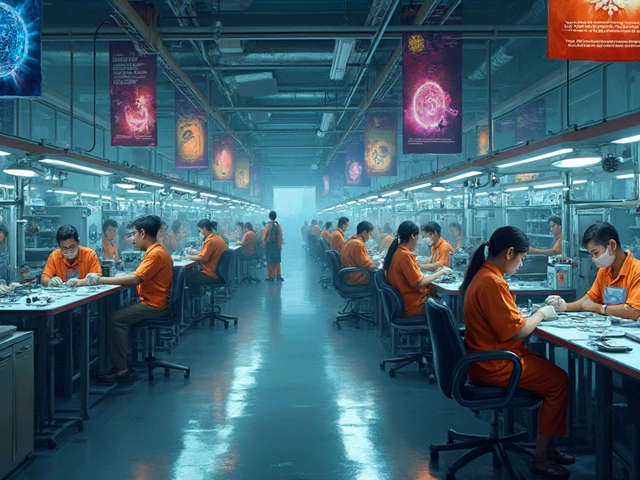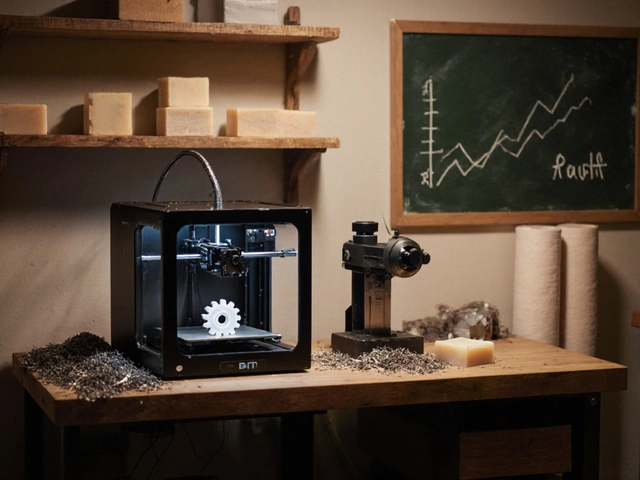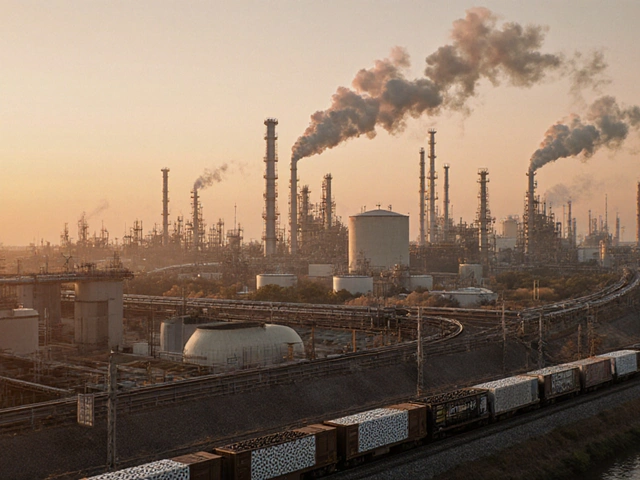In the bustling tapestry of global economies, manufacturing takes center stage as a dynamic and vital component. This industry isn't just about producing goods; it's about driving innovation and growth.
Countries worldwide have embraced the call to manufacture more, and with diverse strategies in place, several nations have emerged as leaders in this sector. By diving deep into the world's most successful manufacturing countries, you'll see how critical government schemes and technological advancements play their roles in shaping robust industries.
This exploration is all about understanding what sets these countries apart in the manufacturing realm and what lessons can be learned for the future of this ever-evolving sector.
- Introduction to Global Manufacturing
- Leading Manufacturing Nations
- Role of Government Schemes
- Technological Innovations in the Sector
- Future of Global Manufacturing
Introduction to Global Manufacturing
Welcome to the world of global manufacturing, where creativity and innovation converge to produce the goods that shape our everyday lives. The manufacturing sector forms the backbone of economies, serving as a primary driver of growth and national prosperity. This intricate dance between technology and labor has transformed how goods are produced and distributed across the world. The journey begins centuries ago, but in the last few decades, technological advances and strategic government policies have positioned the manufacturing sector as a pivotal force in the global economy.
The rise of industrial powerhouses is a story of adaptation and foresight. From automobiles in Germany to semiconductors in South Korea, various regions have leveraged their strengths to become leaders in specific industries. What makes these countries excel in global industry efforts is their emphasis on cutting-edge technology and high-skilled labor. With the principles of lean manufacturing and just-in-time production, these nations have managed to create not just products, but successful business ecosystems.
One notable trend is the shift towards sustainable manufacturing. As climate change poses new challenges, countries are adopting greener practices to maintain competitive advantage. The permeation of Industry 4.0 technologies, like AI and IoT, underscores the need for constant innovation in the sector. In this regard, studies have shown a positive correlation between technological advancements and increases in production efficiency. This reinforces the importance of technology as a cornerstone of modern manufacturing.
The essential role of governments cannot be overlooked. Through strategic incentives and investments, they create fertile ground for manufacturers to thrive. Government schemes often focus on innovation grants, tax breaks, and research funding, which are vital in fostering a robust manufacturing environment. According to data, countries prioritizing these factors have often seen substantial boosts in their industry output. For instance, China's 'Made in China 2025' initiative aims to enhance production capabilities by focusing on high-tech industries, an ambitious effort mirrored by other national strategies globally.
"Manufacturing is more than just putting parts together. It's coming up with ideas, testing principles, and perfecting the engineering, as well as final assembly," noted one industrial expert, highlighting the comprehensive nature of modern manufacturing processes.
Leading Manufacturing Nations
In the realm of global manufacturing, several countries have established themselves as frontrunners, thanks largely to their strategic approaches and government involvement. China, for instance, has long been recognized as the world's manufacturing powerhouse. The "Made in China 2025" strategy is a testament to its ambitions, focusing on boosting innovation and reducing reliance on foreign technology. With an incredible production capacity, China has reshaped the global industrial landscape by offering cost-effective solutions and a skilled workforce.
The United States also stands prominently as a leader in manufacturing, with its technology-driven sectors paving the way. The American government's initiatives like "Manufacturing USA" focus on creating a powerful alliance between private companies and research institutions. This synergy aims at propelling innovation in advanced manufacturing technologies. The impact of these initiatives is reflective in industries such as aerospace and automotive, where American companies are leading global advancements.
Germany, known for its precision engineering, showcases its leadership through the "Industrie 4.0" initiative. This paradigm promotes digitization and automation in manufacturing, reinforcing Germany's position as Europe's industrial heart. The initiative integrates cutting-edge technologies with traditional manufacturing processes, making German industries highly efficient and competitive on a global scale. With robust government support and a focus on sustainable practices, Germany's manufacturing sector is remarkably resilient.
"Industrie 4.0 is not just about technology; it's about ensuring Germany remains at the forefront of industrial leadership on a global scale." - Dr. Angela Merkel
Japan, a pioneer in robotics and machinery, excels in high-tech manufacturing. The country's emphasis on research and development has led to breakthroughs in the electronics and automotive industries. Government schemes in Japan, such as subsidies for technological innovation, support companies in maintaining their competitive edge. The collaboration between industry and government sets Japan apart as a leader in smart manufacturing practices.
Finally, South Korea's meteoric rise as a manufacturing giant is a story of government foresight and private sector agility. The "Korean New Deal" seeks to digitalize manufacturing processes and promote growth in sustainable industries. By focusing on sectors such as electronics and shipbuilding, South Korea has made significant strides in expanding its manufacturing capabilities. The government's active investment in research and development has catalyzed growth and powered the nation's journey to becoming a manufacturing leader.
In summary, these leading nations demonstrate how a blend of strategic government initiatives and innovative industrial practices can position a country at the forefront of the global manufacturing industry. Their success stories provide valuable lessons on harnessing government schemes to transform challenges into opportunities, ultimately shaping economic growth and industrial prowess.
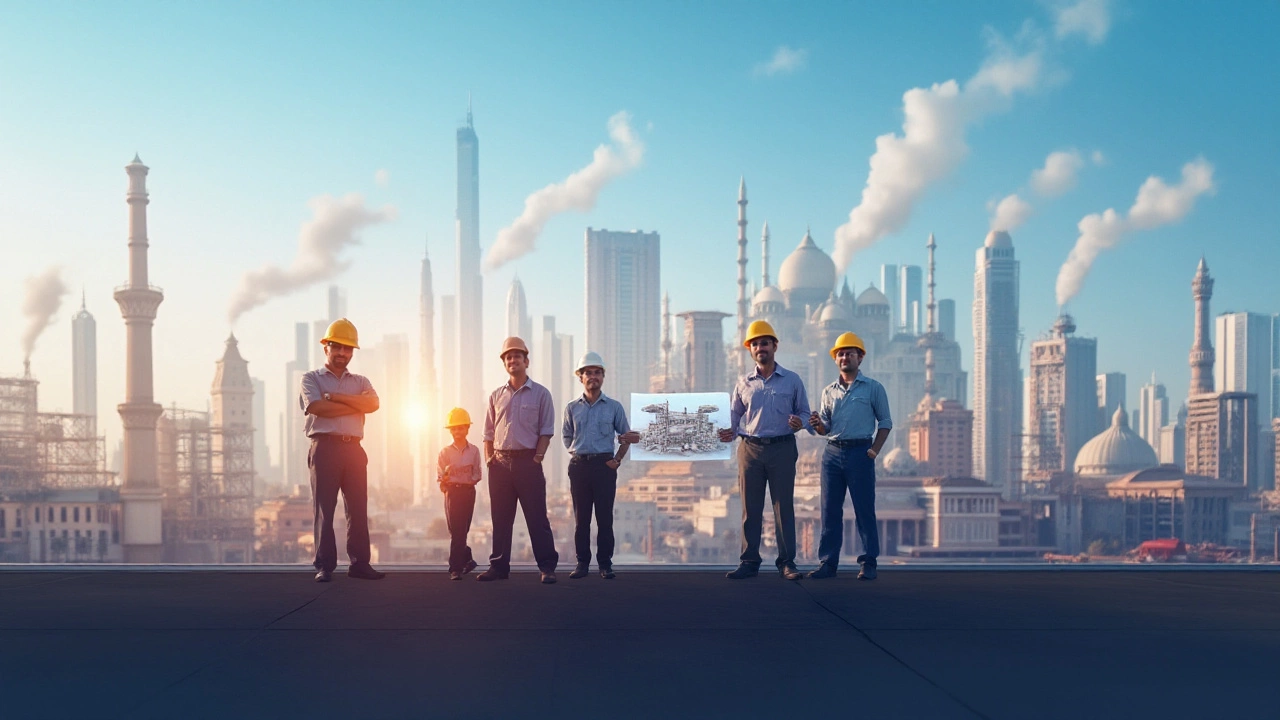
Role of Government Schemes
Government schemes have profoundly impacted the manufacturing landscape across the globe, providing the backbone of support and innovation required for nations to thrive in this sector. Without the strategic vision of public policies and initiatives, many countries might not hold their strong positions in the manufacturing market today. One prominent example is China's 'Made in China 2025' program, which emphasizes technological advancements and the integration of IT within manufacturing. This initiative aims to innovate industries by reducing the country's reliance on foreign technology, enhancing local production capacities.
In India, the 'Make in India' campaign has opened doors to foreign investors while boosting local industries. By simplifying regulatory processes and offering tax benefits, these government-backed initiatives have created an environment conducive to industrial growth. The results are visible, as foreign direct investment (FDI) inflows surged, and the manufacturing sector blossomed, creating millions of job opportunities. It's a blueprint that cherishes collaboration between the private and public sectors, nurturing a promising future for industry players.
In Germany, government schemes within the manufacturing arena are well-integrated with small and medium enterprises. The 'Industry 4.0' initiative showcases this integration, focusing on digitalization and smart technologies. Implementing cutting-edge techniques, like IoT and AI, has allowed German industries to excel globally. The centralized effort to support advanced manufacturing technologies creates a competitive edge unequivocally visible in export numbers and industrial efficiency.
Similarly, the United States government has employed various measures to bolster its industrial strength. Federal incentives such as tax credits for research and development are a major driver encouraging manufacturers to foster innovation. Besides, manufacturing hubs within the USA benefit from comprehensive education and training programs designed to ensure that the workforce is adequately skilled for modern industrial demands. These schemes set the stage for continuous growth and evolution in the manufacturing field.
"Manufacturing has been the key to America's strength and foundation. To stay competitive, public policies must adapt to evolving global standards," cites a report from the Manufacturing Institute.
Globally, the collaborative efforts of governments and private sectors are indispensable in shaping the future of manufacturing. Visionary schemes and robust policies foster an environment where industries can adapt, expand, and thrive. They showcase the pivotal role of governance in building a resilient and competitive manufacturing industry worldwide.
Technological Innovations in the Sector
The current landscape of manufacturing is nothing short of a technological marvel. We've come a long way from the early days of manual assembly lines. One major shift that’s revolutionizing the sector is the advent of automation and robotics. These innovations are allowing manufacturers to produce higher quality products at unprecedented speeds. Robots now perform tasks with extraordinary precision, reducing human error and thereby cutting down on waste. In facilities across the globe, you can witness this technological dance, where robots and humans coexist to achieve outstanding efficiency.
Another major innovation is the incorporation of the Internet of Things (IoT) in the manufacturing processes. IoT devices collect and analyze data, providing insights that help in predictive maintenance and reducing downtime. This integration of technology not only streamlines operations but also fosters an environment of smart manufacturing where data-driven decisions are the norm. In increasing numbers, companies are adopting IoT technologies to enhance productivity and operational efficiency within the sector.
3D Printing and Flexibility in Production
The rise of 3D printing has also marked a significant milestone in manufacturing. This technology allows for rapid prototyping and fosters creativity by enabling the manufacturing of complex parts that were nearly impossible to produce before. It grants manufacturers the flexibility to create customized products at a fraction of the cost and time. As these printers become more advanced, they're expected to revolutionize supply chains and inventory management, impacting global industry strategies.AI and machine learning are making waves in manufacturing too. By utilizing AI algorithms, factories can manage complex processes with ease. AI aids in optimizing supply chains, improving demand forecasts, and enhancing quality control measures. These insights are drawn from massive datasets, resulting in better-informed decisions that genuinely influence profit margins and resource allocations. According to McKinsey & Company, AI-powered initiatives could potentially boost manufacturing productivity by up to 20%.
"The transformation we are witnessing in the manufacturing sector is closely tied to the relentless evolution of technology," notes Dr. Amanda Collins, a technology strategist and industry expert.
The development of smart factories where all mechanisms are fully interconnected and responsive also lies at the industry's forefront. These facilities utilize cutting-edge technologies to achieve remarkable levels of autonomy and adaptability. They self-optimize performance across a broader network, which consequently mitigates system failures. Productivity benefits are clear, but with them come significant demands on infrastructure and cybersecurity, increasing the need for robust information technology frameworks.
Consequently, technology is not only forging ahead with global industry efficiency and quality, but it's also posing new challenges. Staying competitive in this digital age requires manufacturers to continuously adapt and evolve, embracing these emerging technologies to stay ahead in the race.

Future of Global Manufacturing
The future of manufacturing is not just about making things; it's a profound transformation driven by cutting-edge technologies and evolving global dynamics. As industries worldwide gear up for the next decade, a significant shift is underway in how goods are manufactured, distributed, and consumed. The relentless march of technology has already set the stage for a new era of manufacturing excellence, where automation, artificial intelligence (AI), and the Internet of Things (IoT) redefine traditional paradigms.
One of the notable trends is the rise of smart factories, a blend of digital and physical technologies. These factories incorporate robotics and AI to streamline processes, improve precision, and reduce waste. With efficiency and productivity at the core, industries are seeing incredible benefits by reducing human error and enabling continuous production. According to Forbes, "The future belongs to those manufacturers who invest today in training their workforce to handle tomorrow's technology." It's clear that investing in technology and the workforce today will yield significant returns later, shaping the destiny of global manufacturing.
Countries known for their prowess in global industry, such as Germany and Japan, are leading the way by emphasizing both technology and skilled labor in a harmonious balance. Their success stories highlight an essential trend: the empowerment and upskilling of the workforce. A seamless blend of human intelligence and machine efficiency is critical in propelling these nations to the forefront of manufacturing. Moreover, they continually expand their competitive edge through government schemes offering subsidies and incentives to those industries embracing new technology.
In addition to technological growth, sustainability is carving its path in the future of manufacturing. With increasing pressure from global watchdogs and customers, manufacturers are compelled to consider the environmental impact of their practices. Embracing renewable materials, energy-efficient processes, and reducing carbon footprints aren't just noble goals; they are becoming necessary. Many leading players have already set ambitious targets for carbon neutrality and waste reduction, recognizing their profound responsibility. Sustainability is not a buzzword anymore—it's the backbone of global manufacturing's future.
The integration of government schemes to foster innovation is another essential factor influencing the future of manufacturing. In China, government initiatives have led to the rapid adoption of advanced manufacturing technologies. With well-structured programs, investments in research and development have skyrocketed, showing a futuristic vision of an industry eager to embrace change. Such schemes ensure that even smaller industries can access advanced technologies, leveling the playing field. This push for innovation is critical, as it paves the way for another intriguing development: personalized manufacturing.
Personalized manufacturing is set to redefine customer relationships and expectations. With the advancing sophistication of 3D printing technology, manufacturers can now cater to unique and customized requirements at scale. This breakthrough allows producers and designers more creativity and flexibility in meeting consumer needs. It's a revolution that resonates deeply with contemporary consumer demands, where individuality and personalization are paramount.
